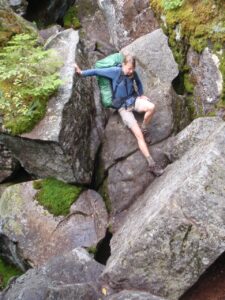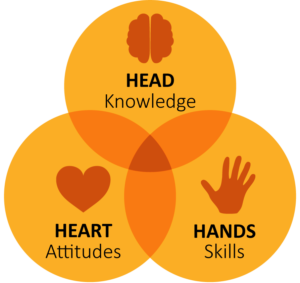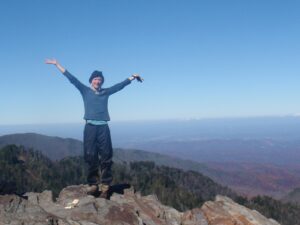May 17, 2021

Have you hiked all or any parts of the Appalachian Trail (AT) or know someone who has? The Appalachian Trail is a 2190-mile hike that winds through 14 states from Georgia to Maine through rocky mountain wilderness, leafy green eastern woodlands, and small towns and farms sprinkled throughout. Carla Robertson, now a life coach, quit her job teaching middle school in 2009 to spend six and a half months hiking the AT on her own. As she says, “it was one of the most life-changing things I ever did. I had no idea I had the strength and bravery to solo hike the trail. It changed everything about how I handled fear, what I believed I need to be happy, and how I structured my life post-hike.”
From an adult learning perspective, preparing for a journey like this exemplifies what we call “holistic learning.” Holistic learning, or whole person learning, means making intentional choices to engage the head, heart and hands in learning activities.

When designing learning events, it can be challenging to imagine learning activities in all three realms. Carla’s Appalachian Trail experience is a great example to help you visualize what you may need to consider for your learners to get the most impact out of the learning event. NOTE: we don’t need to teach in each learning domain every time we teach. It is our responsibility to learn and then decide where the priority focus should be at this time. Do they need to know WHAT something is, HOW to do it, or WHY it is important for them? Or, all three?
Cognitive – Teaching to the Head – Teaching WHAT Something is
In preparing for this adventure there are countless books, online guides, websites, trail magazines, clubs and park service rangers available to get the information you need. Carla shares, “My first go-to for information is the Appalachian Trail Conservancy, which is a clearinghouse of everything to know about the trail from its history and flora and fauna to specific resources about how to prepare for a hike. There are also lots of online groups, some specifically for women, that offer real-time advice and support.”
When designing for head learning:
-
- Did you design to teach facts, methods, theories, concepts, or information?
- Did the learners engage with the new knowledge in a meaningful way?
Psychomotor – Teaching to the Body – Teaching HOW to do Something
The wise thru-hiker will spend time learning and practicing the skills that will be needed to hike long distances, and obtain and prepare food, water and shelter. Carla recalls, “I slowly gathered the light-weight gear I’d need for a thru-hike, then I practiced with it, taking everything out for overnight “shakedown” hikes to be sure I knew that I could rely on my equipment and my skills. I also did a lot of physical training, everything from climbing stairs with a fully loaded pack to weight training, swimming, and more.”
When designing for body learning:
-
- Did you offer a step-by-step process for how to do something?
- Did the learners practice or try out the new skill?
Affective – Teaching to the Heart – Teaching WHY Something is Important
Carla realized how important your mental beliefs are for a journey like this, so after her journey, she created a course for women planning a thru hike and has made presentations for the Trail Dames, an organization that helps women of all shapes, sizes  and skill levels to enjoy hiking. She says, “I knew that only about 20% of those who attempt a thru hike complete the whole trail. I wanted to support other women to be able to have the inner preparation and connection to their personal why to help them when things got hard. For example, I decided ahead of time that if I was unhappy for seven days in a row, I could quit. I never got close to this number. My rare funks lasted one to two days and then there was always something amazing around the corner to reinvigorate me.”
and skill levels to enjoy hiking. She says, “I knew that only about 20% of those who attempt a thru hike complete the whole trail. I wanted to support other women to be able to have the inner preparation and connection to their personal why to help them when things got hard. For example, I decided ahead of time that if I was unhappy for seven days in a row, I could quit. I never got close to this number. My rare funks lasted one to two days and then there was always something amazing around the corner to reinvigorate me.”
When designing for heart learning:
-
- How did you invite stories into the learning to help the heart feel the importance of this content and engage personally?
- How did you ensure a safe space for heart learning?
Remember, no tool or technique is effective in isolation; it only serves the learners when used with intentionality and purpose! Attending to all domains of learning can reinvigorate your learning events, and your learners will appreciate that, as Carla says, there is always something amazing around the corner.
How do you attend to the three domains of learning?
**************************
Rachel Nicolosi is a GLP Partner and Communications Leader and has walked at least 1 mile on the Appalachian Trail with Carla. Here are other GLP blog posts by Rachel.
Carla Robertson, PCC is a life coach who helps people rediscover their truth and make deep shifts in their lives, improving relationships, reconnecting with lost dreams, and seeing the world with more joy and presence. She offers personal coaching, customized experiences in nature, and retreats and courses that bring her clients back into alignment when they’ve been stuck, disconnected or overwhelmed. She is happiest with her feet in the grass or wading in a creek. While she travels widely and never met a trail or tree she didn’t like, her home base is in New Orleans with her husband and cats and beautiful tropical garden.
Check out these related blogs posts:
- From Head to Heart
- Our Bodies Need Attention
- Start with the Heart
- Put Yourself in Someone Else’s Shoes
And this podcast episode: Engaging the Whole Person, Virtually



